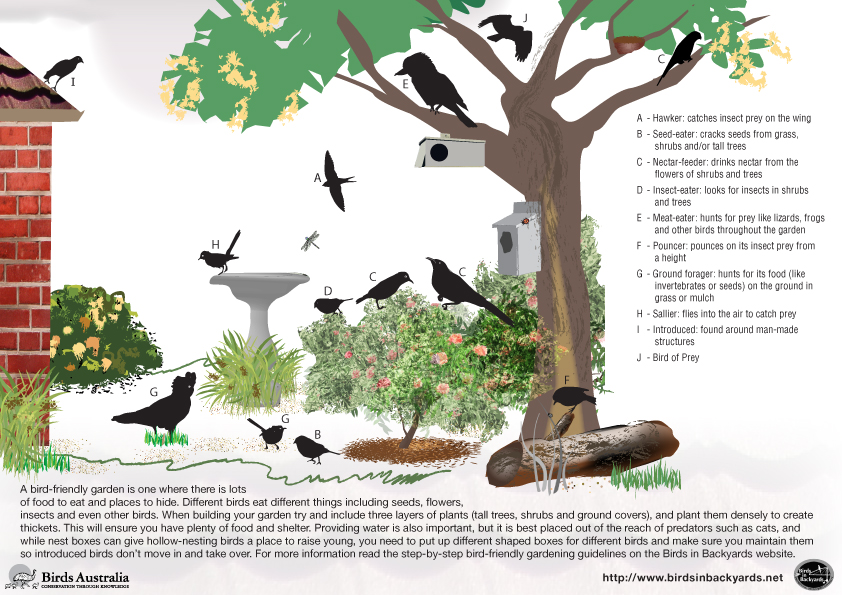You are here
Home ›3. Know What Different Birds Need
Different birds use different parts of our gardens as the following image demonstrates. To download and print this image go to our Birds in Backyards Resources page.
Use the following table as a guide for what types of plants are suitable for different types of birds (note - this is not an exhaustive list but is indicative of some of the types of native plants available):
| Bird Type | Food Source | Habitat preference |
|---|---|---|
|
Large Nectarivores (nectar feeders) Honeyeaters and some parrots e.g. Noisy Miner, Red and Little Wattlebirds, Rainbow and Scaly-breasted Lorikeets |
Banksia, Callistemon (Bottlebrush), Eucalyptus, Grevillea, Hakea, Melaleuca (Paperbark) |
Shrubs and trees for foraging, perching and nesting. Some require hollows for nesting |
|
Small Nectarivores (nectar feeders) Honeyeaters e.g. Eastern and Western Spinebills, New Holland Honeyeater, Brown Honeyeater |
Banksia, Callistemon (Bottlebrush), Eucalyptus, Grevillea, Hakea, Melaleuca (Paperbark), Correa | Spend most time foraging and perching in shrubs but also use trees. Generally nest in dense shrubs. |
|
Granivores (seed eaters) Parrots, finches and pigeons e.g. Eastern Rosella, Pale-headed Rosella, Galah, Sulphur-Crested Cockatoo, Common Bronzewing, Red-Browed Finch, Double-Barred Finch, Chestnut-breasted Manikin |
Trees and shrubs: Acacia (Wattle), Casuarina (She-oak), Leptospermum (Tea-tree) Grasses: Lomandra, Themeda, Poa |
Utilise shrubs and trees for perching, nesting and foraging but also forage on mature grasses |
|
Frugivores (fruit eaters) Pigeons and cuckoos e.g. Wonga Pigeon, Common Koel, Silvereye, Satin Bowerbird |
Ficus (Figs), Syzygium (Lillipilly), Eleocarpus (Quandong) | Shrubs and trees are important habitat |
|
Insectivores (insect eaters) e.g. Superb Fairy-wren, Eastern Yellow Robin, Spotted and Striated Pardalotes, Willie Wagtail |
Insects and other invertebrates either on the bark and foliage of shrubs and trees or on the ground. Species like Acacia and Leptospermum attract a lot of insects | Dense shrubs important for protection and nest sites as well as some open areas for foraging |
|
Carnivores (meat eaters) e.g. Grey and Pied Currawongs, Laughing Kookaburra, Grey and Pied Butcherbirds, Powerful Owl, Black-shouldered Kite, Peregrine Falcon |
Other birds, reptiles, frogs, mammals, invertebrates | Tall trees for perching, roosting and nesting. Some require hollows for nesting |










